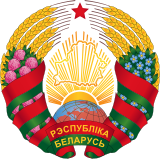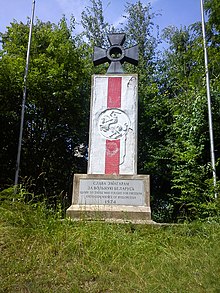Belarusian Americans
Беларускія амэрыканцы | |
|---|---|
| Total population | |
| 600,000[1] (without descendants) | |
| Regions with significant populations | |
| New York,New Jersey,Connecticut,Cleveland,Chicago,Los Angeles,Detroit | |
| Languages | |
| Belarusian,Russian,American English | |
| Religion | |
| PredominantlyOrthodoxy,Roman Catholicism,Judaism | |
| Related ethnic groups | |
| Russian Americans,Ukrainian Americans,Rusyn Americans,Polish Americans,otherSlavic Americans |
| Part ofa serieson |
| Belarusians |
|---|
 |
| Culture |
| By regions |
| Closely related peoples |
| Religion |
| Languages and dialects |
| Topics |
Belarusian Americans,also known asWhite Russian Americans[2]andWhite Ruthenian Americans[3](Belarusian:Беларускія амэрыканцы,Biełaruskija amerykancy), areAmericanswho are of total or partialBelarusianancestry.
History
[edit]There is an assumption that the first Belarusian settlers in the United States, who settled there at the beginning of the 17th century inVirginia,could have been brought as Slavic slaves by CaptainJohn Smith,who visitedBelarusin 1603.[3]The first wave of mass emigration from Belarus started in the final decades of the nineteenth century and continued untilWorld War I.They emigrated to the United States viaLibava(Liepāja,Latvia) and northern Germany. When they arrived, most settled inNew York,Philadelphia,Boston,andBaltimore.However, most of these first Belarusians were registered either as Russians (those who were Orthodox Christians) or as Poles (Roman Catholics).[3]This was because the first wave of immigrants came before the full development and spread ofBelarusian nationalism.[4][5]Most ethnic Belarusians (those who were not genetically or culturally Polish, Lithuanian, or Jewish) considered themselves to be Russian.[4][6]Furthermore, even today, those who descend from pre-World War I immigrants often use the more archaic term "White Russian" to describe their ancestry instead of "Belarusian".[2]
Demography
[edit]This sectionneeds additional citations forverification.(February 2023) |

According to the1990 United States Census,only 4,277 respondents claimed Belarusian ancestry; there are no reports as to the estimated population from the2000 census.[7]The majority of thepre-Revolutionaryimmigrants from Belarus who were ethnic Belarusians identified as Russian, more or less holdingRussophilicor Westrussianist views.[8][9]A large portion of theRussian Americancommunity consisted of immigrants from Belarus. Belarus had, and still has, aPolish minorityconsisting of ethnic Poles, the descendants of the Polish nobility and gentry, as well as descendants ofPolonizedBelarusian peasants.[10][11]In addition, the term "Belarusian" only became common near the end of the Soviet Union's existence, and most persons of Belarusian ancestry in the United States would be unaware of the term, referring to themselves as "White Russian" rather than "Belarusian".
Since it was customary inAmerican Englishof that time to use a historicalRutheniandesignation for variousEast Slavicpeoples, Belarusians in the U.S. were sometimes referred to asWhite Ruthenians.For example, the first Belarusian-American newspaper,Belaruskaja trybuna(Belarusian:Беларуская трыбуна,lit. 'Belarusian Tribune'), was published since 1926 by theWhiteruthenian National Association,and had an English subtitle:Whiteruthenian Tribune.[12]
The largest concentrations of Belarusian Americans are in themetropolitan New Yorkarea,New Jersey(especiallyHighland ParkandSouth River),Cleveland(and its suburbs),Chicago(recent immigrants concentrated aroundWheeling),Los Angeles,Sacramento(largely aroundOrangevaleandNorth Highlands) andDetroit.
There were several waves of Belarusian influx into the U.S., one before theRussian Revolution,then in 1919-1939 fromWestern Belarus,then in the late 1940s-early 1950s (after the Second World War), and after the collapse of the USSR in the 1990s.
One major group of Belarusian immigrants to the U.S. are BelarusianJewswho migrated starting in the mid-19th century, having faced discrimination in theRussian Empire,which Belarus was part of at the time.
According to the 2000 Census Bureau report,[13]38,505 people who were born in Belarus lived in the United States. 1,363 of them spoke theBelarusian languageat home.[14]
Belarusian-born population
[edit]Belarusian-born population in the U.S. since 2010:[15]
| Year | Number |
|---|---|
| 2010 | 56,217 |
| 2011 | |
| 2012 | |
| 2013 | |
| 2014 | |
| 2015 | |
| 2016 |
Education and culture
[edit]There are several organizations in the United States that have developed a system of secondary schools in places with communities of Belarusian descent. These organizations have the goal of teaching the language, culture, and religious traditions of Belarus. Thus the Belarusian culture is represented by choirs, theatrical groups, and musical and dance ensembles. One of the more prominent associations is theBelarusan American Association.[3] Red, white, black and green colors dominate in the nationalcostume.The national costumes differ depending on the region of Belarus. In the 1950s theSt. Euphrosynia Belarusian Orthodox Churchwas created inSouth River, New Jersey.
Cuisine
[edit]Belarusian cuisinehas left a trace in the life of theAmericans.One of the proofs is the traditional bagel. The Americans also know Belarusianpierogi,kielbasyand cabbages. The Belarusian cuisine is dominated by various grains,potatoes,beef, pork and mushrooms. Actually, many dishes are cooked from potatoes; for example,draniki,babka,etc. There are also dishes similar to the ones of neighboring countries (Lithuania,Latvia,Ukraine,Russia,Poland):cabbage rolls,bortsch,cold beetroot soup ormeat jelly.[16]
Notable people
[edit]| Lists of Americans |
|---|
| By US state |
| By ethnicity |
This sectionneeds additional citations forverification.(January 2020) |
- Mary Antin
- Irving Berlin
- Larry Brown
- Dick Dale
- Kirk Douglas
- Harrison Ford
- Al Franken
- Alex Galchenyuk
- Wayne Gretzky
- Scarlett Johansson
- Larry King
- Barys Kit
- Olga Korbut
- Tadeusz Kościuszko
- Lisa Kudrow
- Jared Kushner
- George de Mohrenschildt
- Siarhei Navumchyk
- Dasha Nekrasova
- Gwyneth Paltrow
- Zianon Pazniak
- Greg Puciato
- Dmitry Sholokhov
- Nikolai Sudzilovsky
- Jazep Varonka
- Gary Vaynerchuk
- Jurka Vićbič
- Marianne Williamson
- Jan Zaprudnik
- Zebbler
See also
[edit]References
[edit]- ^Как живешь, белорусская диаспора?[How are you, Belarusian diaspora?].belarustime.ru(in Russian). 2006. Archived fromthe originalon March 13, 2012.
- ^abAmerican Immigration: A Student Companion.p. 52.
- ^abcdVituat Kipel (2006)."Belarusan Americans".everyculture.RetrievedJanuary 14,2016.
- ^abBekus, Nelly (2010).Struggle over identity: the official and the alternative "Belarusianness".Budapest: Central European Univ Press.ISBN978-963-9776-68-5.
- ^Rudling, Per Anders (2015).The rise and fall of Belarusian nationalism, 1906-1931.Pitt series in Russian and East European studies. Pittsburgh, Pa: University of Pittsburgh Press.ISBN978-0-8229-6308-0.
- ^Magocsi, Paul R. (1996).The Russian Americans.The immigrant experience (1. print ed.). New York: Chelsea House Publ. pp. 19, 41.ISBN978-0-7910-3367-8.
- ^"Belarus".Slavic Heritage Coalition.1996. Archived fromthe originalon December 29, 2013.
- ^Гронский, А. Д. (April 27, 2014)."Образ Российской империи и белорусского национального движения в новом школьном учебнике по истории Белоруссии".Archived fromthe originalon April 27, 2014.
- ^Заблоцкая, М. В."Идеи «западноруссизма» в политической и культурно-национальной жизни Беларуси в конце XIX — начале XX века"(PDF).Archived fromthe original(PDF)on December 13, 2013.
- ^"Belarus History - PolishRoots".polishroots.RetrievedDecember 28,2023.
- ^Kamusella, Tomasz (2013)."Germanization, Polonization, and Russification in the partitioned lands of Poland-Lithuania".Nationalities Papers.41(5): 815–838.doi:10.1080/00905992.2013.767793.hdl:10023/4055.ISSN0090-5992.
- ^Kipel 1999,p. 408.
- ^"Profile of Selected Demographic and Social Characteristics: 2000 - People Born in Belarus"(PDF).U.S. Census Bureau.2000.RetrievedJanuary 14,2016.
- ^"Detailed Languages Spoken at Home and Ability to Speak English for the Population 5 Years and Over for the United States: 2006-2008".U.S. Census Bureau.April 2010. Archived fromthe original(XLS)on October 19, 2010.
- ^"American FactFinder - Results".Archived fromthe originalon February 14, 2020.RetrievedApril 23,2018.
- ^Long, Lucy M. (July 15, 2016).Ethnic American Cooking: Recipes for Living in a New World.Rowman & Littlefield. p. 18.ISBN978-1-4422-6734-3.
Sources
[edit]- Kipel, Vitaut (1999).Belarusans in the United States.Lanham: University Press of America.ISBN9780761813064.
